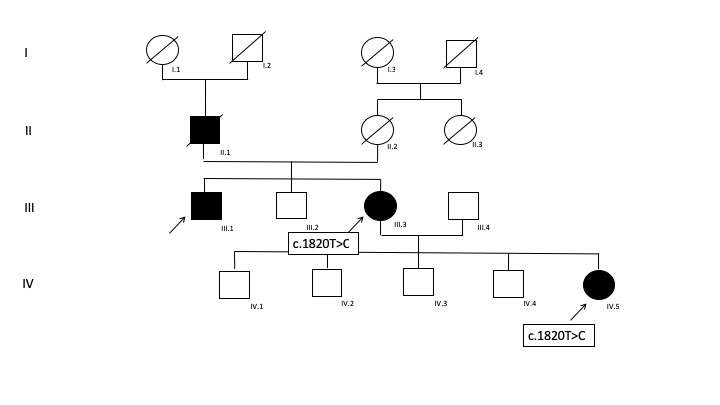Session Information
Date: Tuesday, September 24, 2019
Session Title: Dystonia
Session Time: 1:45pm-3:15pm
Location: Les Muses Terrace, Level 3
Objective: We present a family carrying ANO3 mutation and exhibiting a myoclonus-dystonia and tremor phenotype.
Background: Mutations of Anoctamine 3 gene (ANO3) are a rare cause of dystonia which have first been described in families with tremulous craniocervical dystonia.
Method: Our family is composed of 4 affected members, as described in the family tree (Fig.1).
Results: Patient III.1. developed walking difficulties when 12 years-old because of a left leg dystonia with myoclonus. He also exhibited a mild dystonia of the left arm and a slight facial dystonia with blepharospasm. The evolution was slow and he could still walk, albeit with help, when 60 years-old. He died at 65 years old from unknown cause. Patient III.3. developed bilateral postural arm tremor at the age of 16. This tremor also concerned the head. She was diagnosed as essential tremor. Then, 20 years later, she progressively developed walking difficulties with axial dystonia and generalized bradykinesia. Patient IV.5 developed a left leg dystonia and walking difficulties when 12 years-old. Then, during the next 10 years, the dystonia generalized with a prominent axial presentation. She also developed generalized myoclonus. Only zonisamide was partially effective on myoclonus. Finally, she underwent pallidal deep brain stimulation (DBS) at 33 years of age with a good improvement of myoclonus. None of the patients were exposed to neuroleptics or had a neonatal anoxia. Genetic test for DYT1, 11 and 6 were negative. Brain MRI and [123 I]-FP-β-CIT SPECT imaging were normal. Genetic analysis was then performed from a panel of 127 genes responsible for movement disorders. Targeted high-coverage sequencing was applied to DNA samples taken from these patients. ANO3 gene mutation c.1820T>C was found in patients III.3 and IV.5. The asymptomatic brother of patient IV.5, subject IV.4 was tested and did not carry the mutation, which supports the pathogenicity of this novel ANO3 mutation.
Conclusion: We report a new ANO3 mutation responsible initially of young-onset lower limb dystonia or arm tremor. Then, the clinical presentation slowly worsens and leads to a generalized dystonia combined with tremor and/or myoclonus. Interestingly there is, within this family a significant phenotypic variability. Furthermore, GPi deep brain stimulation was be partially effective in one patient of this series.
To cite this abstract in AMA style:
C. Laurencin, E. Broussolle, T. Danaila, M. Anheim, J. Chelly, S. Thobois. A novel heterozygous ANO3 mutation responsible for myoclonus-dystonia [abstract]. Mov Disord. 2019; 34 (suppl 2). https://www.mdsabstracts.org/abstract/a-novel-heterozygous-ano3-mutation-responsible-for-myoclonus-dystonia/. Accessed April 22, 2025.« Back to 2019 International Congress
MDS Abstracts - https://www.mdsabstracts.org/abstract/a-novel-heterozygous-ano3-mutation-responsible-for-myoclonus-dystonia/

